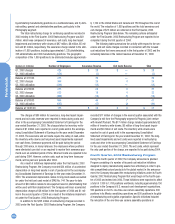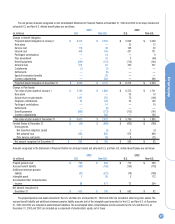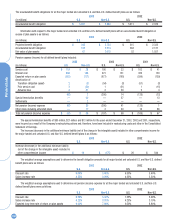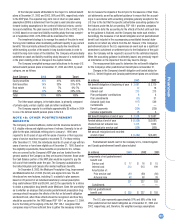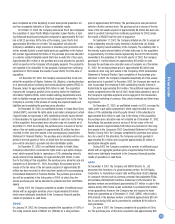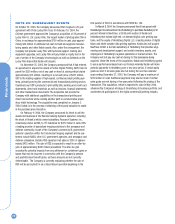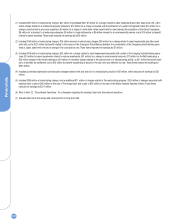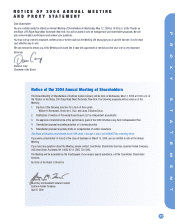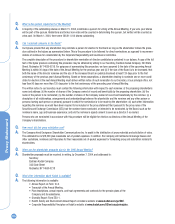Kodak 2003 Annual Report Download - page 74
Download and view the complete annual report
Please find page 74 of the 2003 Kodak annual report below. You can navigate through the pages in the report by either clicking on the pages listed below, or by using the keyword search tool below to find specific information within the annual report.
Financials
74
million in cash. The acquisition was accounted for as a purchase with $10
million allocated to tangible net assets, $37 million allocated to goodwill
and $11 million allocated to other intangible assets. The acquisition of
Ofoto has accelerated Kodak’s growth in the online photography market
and has helped drive more rapid adoption of digital and online services.
Ofoto offers digital processing of digital images and traditional film, top-
quality prints, private online image storage, sharing, editing and creative
tools, frames, cards and other merchandise.
On February 7, 2001, the Company completed its acquisition of sub-
stantially all of the imaging services operations of Bell & Howell Company.
The purchase price of this stock and asset acquisition was $141 million in
cash, including acquisition and other costs of $6 million. The acquisition
was accounted for as a purchase with $15 million allocated to tangible net
assets, $70 million allocated to goodwill, and $56 million allocated to
other intangible assets, primarily customer contracts. The acquired units
provide customers worldwide with maintenance for document imaging
components, micrographic-related equipment, supplies, parts and service.
During 2001, the Company also completed additional acquisitions
with an aggregate purchase price of approximately $122 million in cash
and stock, none of which were individually material to the Company’s
financial position, results of operations or cash flows.
NOTE 22: DISCONTINUED OPERATIONS
2003
During the three-month period ended March 31, 2003, the Company
repurchased certain properties that were initially sold in connection with
the 1994 divestiture of Sterling Winthrop Inc., which represented a portion
of the Company’s non-imaging health businesses. The repurchase of these
properties allows the Company to directly manage the environmental
remediation that the Company is required to perform in connection with
those properties, which will result in better overall cost control (see Note
11, “Commitments and Contingencies”). In addition, the repurchase elimi-
nated the uncertainty regarding the recoverability of tax benefits associat-
ed with the indemnification payments that were previously being made to
the purchaser. Accordingly, the Company reversed a tax reserve of approx-
imately $15 million through earnings from discontinued operations in the
accompanying Consolidated Statement of Earnings for the twelve months
ended December 31, 2003, which was previously established through dis-
continued operations.
During the three-month period ended March 31, 2003, the Company
received cash relating to the favorable outcome of litigation associated
with the 1994 sale of Sterling Winthrop Inc. The related gain of $19 million
was recognized in loss from discontinued operations in the Consolidated
Statement of Earnings for the year ended December 31, 2002. The cash
receipt is reflected in the net cash provided by (used in) discontinued
operations component in the accompanying Consolidated Statement of
Cash Flows for the twelve months ended December 31, 2003.
During the fourth quarter of 2003, the Company recorded a net of tax
credit of $7 million through discontinued operations for the reversal of an
environmental reserve, which was primarily attributable to positive devel-
opments in the Company’s remediation efforts relating to a formerly
owned manufacturing site in the U.S. In addition, during the fourth quarter
of 2003, the Company reversed state income tax reserves of $3 million,
net of tax, through discontinued operations due to the favorable outcome
of tax audits in connection with a formerly owned business.
2002
The net loss from discontinued operations of $23 million in the
accompanying Consolidated Statement of Earnings for the twelve months
ended December 31, 2002 reflects losses incurred from the shutdown of
Kodak Global Imaging, Inc., which amounted to $35 million net of tax, par-
tially offset by net of tax earnings of $12 million related to the favorable
outcome of litigation associated with the 1994 sale of Sterling Winthrop
Inc.
NOTE 23: SEGMENT INFORMATION
Current Segment Reporting Structure
The Company currently reports financial information for three reportable
segments (Photography, Health Imaging and Commercial Imaging) and All
Other. This operational structure, which is centered around strategic prod-
uct groups, reflects how senior management reviews the business, makes
investing and resource allocation decisions, and assesses operating per-
formance. The strategic product groups from existing businesses and
geographies have been integrated into segments that share common
technology, manufacturing and product platforms, and customer sets.
The Photography segment derives revenues from consumer film
products, sales of origination and print film to the entertainment industry,
sales of professional film products, traditional and inkjet photo paper,
chemicals, traditional and digital cameras, photoprocessing equipment
and services, and digitization services, including online services. The
Health Imaging segment derives revenues from the sale of digital prod-
ucts, including laser imagers, media, computed and direct radiography
equipment and healthcare information systems, as well as traditional
medical products, including analog film, equipment, chemistry, services
and specialty products for the mammography, oncology and dental fields.
The Commercial Imaging segment derives revenues from microfilm equip-
ment and media, wide-format inkjet printers, inks and media, scanners,
other business equipment, media sold to commercial and government
customers, long-term government contracts, and graphics film products
sold to the Kodak Polychrome Graphics joint venture. The All Other group
derives revenues from the sale of OLED displays, imaging sensor solutions
and optical products to other manufacturers.
Transactions between segments, which are immaterial, are made on
a basis intended to reflect the market value of the products, recognizing
prevailing market prices and distributor discounts. Differences between
the reportable segments’ operating results and net assets and the
Company’s consolidated financial statements relate primarily to items held
at the corporate level, and to other items excluded from segment operat-
ing measurements.
No single customer represented 10% or more of the Company’s total
net sales in any period presented.
Segment financial information is shown on the following page.


